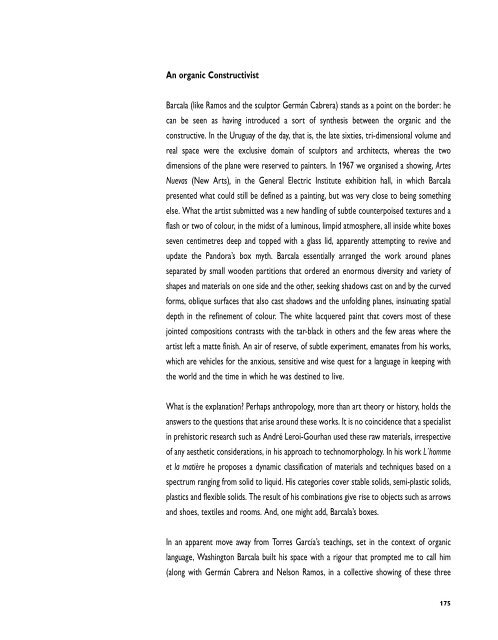Catálogo de la exposición - Fundación César Manrique
Catálogo de la exposición - Fundación César Manrique
Catálogo de la exposición - Fundación César Manrique
Create successful ePaper yourself
Turn your PDF publications into a flip-book with our unique Google optimized e-Paper software.
An organic Constructivist<br />
Barca<strong>la</strong> (like Ramos and the sculptor Germán Cabrera) stands as a point on the bor<strong>de</strong>r: he<br />
can be seen as having introduced a sort of synthesis between the organic and the<br />
constructive. In the Uruguay of the day, that is, the <strong>la</strong>te sixties, tri-dimensional volume and<br />
real space were the exclusive domain of sculptors and architects, whereas the two<br />
dimensions of the p<strong>la</strong>ne were reserved to painters. In 1967 we organised a showing, Artes<br />
Nuevas (New Arts), in the General Electric Institute exhibition hall, in which Barca<strong>la</strong><br />
presented what could still be <strong>de</strong>fined as a painting, but was very close to being something<br />
else. What the artist submitted was a new handling of subtle counterpoised textures and a<br />
f<strong>la</strong>sh or two of colour, in the midst of a luminous, limpid atmosphere, all insi<strong>de</strong> white boxes<br />
seven centimetres <strong>de</strong>ep and topped with a g<strong>la</strong>ss lid, apparently attempting to revive and<br />
update the Pandora’s box myth. Barca<strong>la</strong> essentially arranged the work around p<strong>la</strong>nes<br />
separated by small woo<strong>de</strong>n partitions that or<strong>de</strong>red an enormous diversity and variety of<br />
shapes and materials on one si<strong>de</strong> and the other, seeking shadows cast on and by the curved<br />
forms, oblique surfaces that also cast shadows and the unfolding p<strong>la</strong>nes, insinuating spatial<br />
<strong>de</strong>pth in the refinement of colour. The white <strong>la</strong>cquered paint that covers most of these<br />
jointed compositions contrasts with the tar-b<strong>la</strong>ck in others and the few areas where the<br />
artist left a matte finish. An air of reserve, of subtle experiment, emanates from his works,<br />
which are vehicles for the anxious, sensitive and wise quest for a <strong>la</strong>nguage in keeping with<br />
the world and the time in which he was <strong>de</strong>stined to live.<br />
What is the exp<strong>la</strong>nation? Perhaps anthropology, more than art theory or history, holds the<br />
answers to the questions that arise around these works. It is no coinci<strong>de</strong>nce that a specialist<br />
in prehistoric research such as André Leroi-Gourhan used these raw materials, irrespective<br />
of any aesthetic consi<strong>de</strong>rations, in his approach to technomorphology. In his work L´homme<br />
et <strong>la</strong> matière he proposes a dynamic c<strong>la</strong>ssification of materials and techniques based on a<br />
spectrum ranging from solid to liquid. His categories cover stable solids, semi-p<strong>la</strong>stic solids,<br />
p<strong>la</strong>stics and flexible solids. The result of his combinations give rise to objects such as arrows<br />
and shoes, textiles and rooms. And, one might add, Barca<strong>la</strong>’s boxes.<br />
In an apparent move away from Torres García’s teachings, set in the context of organic<br />
<strong>la</strong>nguage, Washington Barca<strong>la</strong> built his space with a rigour that prompted me to call him<br />
(along with Germán Cabrera and Nelson Ramos, in a collective showing of these three<br />
175















![Becas y premios de la Fundación César Manrique [1997-2006]](https://img.yumpu.com/20766851/1/184x260/becas-y-premios-de-la-fundacion-cesar-manrique-1997-2006.jpg?quality=85)
